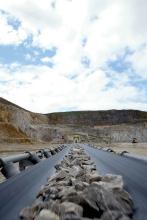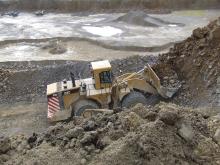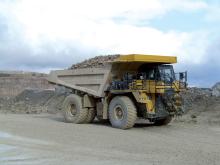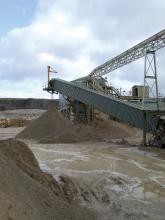
Construction of a motorway dividing the Mions Quarry in Lyon, France gave the site the opportunity to change its approach to extraction and processing. Claire Symes visited the site to find out more
Investment in new road infrastructure in the Rhone Alpes region of France in the early 1990s helped to bring more development and new industry into the city of Lyon. The construction work itself was good news for the local aggregates market but for Perrier TP's Mions Quarry it brought other opportunities for future growth.
Work included construction of a new motorway which divided the sand and gravel reserves of the Mions Quarry in two, effectively splitting the next extraction area from the processing plant. Rather than transporting material by road between the two sites, Perrier accelerated extraction closest to the processing plant and invested in a new state of the art plant on the other side of the motorway.
The result is a fully automated state-of-the-art crushing, screening and blending facility to process sand and gravel extracted on site with conveyors linking it to a ready mixed concrete plant, asphalt plant and direct truck loading system.
Lyonnais heritage
Perrier TP is one of the oldest quarrying names in the Lyonnais aggregates sector but since 2000 it has been owned by the
Operation of Perrier's network of quarries is the responsibility of quarry director Bernard Germain, while day to day operation of the Mions quarry is overseen by quarry manager Emmanuel Sicamois.
"The Perrier TP company started operation in 1922 as a transportation business, particularly for coal, and then moved into the road construction business after the second world war and entry into the quarry business followed on from that," explained Germain.
Globally, the Colas group operates more than 500 quarries with an annual production of 100million tonnes. Colas first moved into the aggregates sector 30 years ago. "We owned quarry operations before that but there was a more decisive move in the 1970s," said Colas licensing and export division executive manager Jean-Claude Roffe. "That strategy coincided with investment in the French road network and it became clear aggregates supply was an important factor in delivering those projects." Colas has gradually developed its current structure by acquiring and merging small earthmoving and quarrying businesses into the parent company. Nonetheless, Colas prefers to retain the original company names of its subsidiaries and build on the local reputation businesses in the same way as Perrier had.
Perrier's original Corbas site opened in 1964 and the site's first fixed crushing and screening plant was installed in 1971, followed by an aphalt plant in 1989 and the first recycling facilities in 1996. Production at the site steadily grew as the quarry established its glacial moraine gravels within the local construction market as some of the best for concrete manufacture in the region.
However, when the new A46 South motorway was built between 1990 and 1992, dividing the reserves in two, it was clear that a new approach was needed. This led Perrier to focus extraction and restoration on the Corbas side of the site and then to relocate with investment in a new crushing and screening plant to the Mions side of the motorway.
The former Corbas Quarry that ceased operation in 2000 is now completely restored and has been developed as a prison.
"Today the Mions Quarry produces around 700,000tonnes of aggregates per year and has more than 27 years of reserves," said Sicamois. "This material is either fed directly to our asphalt plant that produces around 250,000tonnes per year, is sold to external customers, or is delivered to an on site ready mixed concrete plant operated by
"We also run a recycling operation at the site that processes 300,000tonnes per year of demolition waste and 40,000tonnes of asphalt planings for recycling."
Investment
Despite the scale of operation at Mions Quarry, the site is eerily quiet except for customers arriving to collect aggregates, concrete and asphalt and even that has a feeling of well ordered calm. The reason for this appearance is that almost the entire operation is automated. The only piece of mobile equipment regularly working at the site is a wheeled loader that excavates from the face and loads the field conveyor.
"Transport of material between each processing operation is carried out by covered conveyor and the crushing and screening houses are also enclosed," explained Germain. "The crushed, screened and washed materials are all stored in silos, which are connected to the concrete plant, asphalt plant and customer delivery facilities by a further network of covered conveyors.
"Enclosing the plant in this way allows us to carefully control both noise and dust from the site. Our nearest neighbours are a few hundred metres away and we operate under tight noise levels laid down in the planning permission for the site, but thanks to the design of the facility we operate well below these levels. The noise limit at the site boundary has to be below 60d(B)A and not more than 5d(B)A above background levels." To achieve its environmental and safety aims at Mions Quarry, Perrier invested €10million in the new
According to Germain, this investment has allowed Mions Quarry to increase its output through greater efficiency. "In 2000 the quarry produced 500,000tonnes and operated two shifts," he said. "Today we produce almost 50% more and still have additional capacity as we now only operate one shift per day.
"Demand has also increased because our presence within the Colas group creates a ready market for our aggregates."
Face extraction
At Mions, Perrier uses a 14m high single bench and extracts directly from the face using a wheeled loader. "We excavate the glacial moraine deposit in sections 35 to 50m deep from the face across a 200m wide strip," said Sicamois. "The material is weakly cemented so can be dug directly from the face and loaded into the field conveyor. This feeds directly into a 3500tonne surge stockpile silo that has sufficient capacity for continuous supply in the case of a wheeled loader breakdown." The field conveyor is a relatively recent addition to the quarry, having been commissioned in 2007. "Before that we used a fleet of four
Processing
From the surge pile silo, the 0-160mm feed stock is passed through a double deck Sandvik CS144 screen to separate off the 0-20mm fraction, while the remainder goes to the crushing house. The uncrushed 0-20mm material is then further screened and washed by a triple deck CS144 screen before storage in five silos to serve the concrete plant and customer collection facility.
"We have five 1200tonne silos for storage of the natural, uncrushed aggregates," said Germain. "There is one each for the 4-12mm and 12-20mm sized material. The other three silos are used sequentially for the 0-4mm size to allow it to fully dewater before use. The sand is passed through a dewatering plant before placing in the silo." The 20-160mm feed material sent to the crushing house is processed by the three Sandvik cone crushers and is destined for the customer collection and asphalt plant.
"The cone crushers were chosen for the Mions Quarry plant because of the cubicity it can produce," said Germain. "The cones offer the best output and low wear rates for this deposit, but 99% of crushers in France are cones because of the tight aggregates specifications here." The material is then dry screened using a system of two Sandvik CS144 and two Sandvik CS108 triple deck screens to produce seven different sizes of crushed aggregates. This material is also stored in silos - two with 900tonne capacity and five with 1200tonne capacity.
Each of the screens is surrounded by a membrane to try to contain the dust and prevent spreading even within the screening house. The screens are also fitted with polyurethane screening media as standard to further reduce noise levels. "The polyurethane media does cost more but it has a longer service life," said Sicamois. "It is also lighter and easier to handle, which makes maintenance easier." The crushing and screening plant produces 10 different product grades and around 70% of the material is washed. "These different grades of material are mixed, according to demand, and we have 40 different mixed aggregates products available for sale to customers," said Sicamois.Production grades
Washed natural aggregates:
0-4mm
4-12mm
12-20mm
Crushed aggregates:
0-2mm
0-4mm
2-4mm
4-6mm
6-10mm
10-14mm
10-20mm
Direct dispatch
Around 55% of the material produced at Mions Quarry is transported away from the site and not used by the concrete or asphalt plants. Of that volume, about 20% is used within the Colas group and the rest is sold to customers. "We deliver around a third of the externally sold aggregates directly to customers with a fleet of on road haulage trucks. The rest is collected by sub-contractors," said Germain. "The site is only 15km from the centre of Lyon so demand is quite high."
Material produced at the quarry sells for an average ex-works price of €11 per tonne but the actual cost varies depending on the mix with crushed aggregates selling for around €7.5 per tonne and the best natural aggregates going for €25 per tonne.
Once loaded, the trucks drive under a specially installed water spray bar system to ensure any sand loads are damped down before leaving the site. "We won an environmental award from
Paving the way
The asphalt plant at Mions Quarry operates 24hours a day if there is call for material round the clock and has six 80,000litre bitumen tanks on site to ensure it can meet demand. The site also has four 60tonne storage silos for asphalt and two 120tonne long term storage facilities with insulation to keep the material up to temperature for around 36hours, which helps the plant to meet peaks in demand.
The Ermont Magnum 360 asphalt plant has been designed specifically for the site and has a capacity of 360tonnes per hour.
The plant always uses at least 10% recycled asphalt planings in the asphalt mix, which is brought through from the recycling side of the operation.
"The plant is gas powered because this offers us the best output with lower emissions and no need for fuel storage on site," said asphalt plant manager Jean-Paul Notin. "This batching design is better in terms of quality and ability meet demand for different recipes than the previous continuous plant on the Corbas site. Being located close to an urban area means that demand can vary from 1tonne upwards, with up to 50 different formulations required in one day, although we can produce around 150 different asphalt mixes."
Safety access
Despite moving the operation of the site to avoid the quarry being divided by the motorway, the site is still crossed by a local road. But to avoid quarry traffic mixing with the local traffic, Perrier has built a tunnel under this road to link the two side of the site. "The recycling operations and offices are on one side, and the main quarry on the other," explained Sicamois. "Using the tunnel, any traffic coming to and from the site can directly access the motorway without passing through any of the nearby residential areas. Reducing the interaction of the traffic is much safer for everyone." In fact, this reduction in interaction concept has been used throughout the quarry with the conveyor system designed to reduce vehicle movements on site. The layout for the collection systems has also been carefully separated and signposted.
"The focus is very much on high quality production and safety," said Germain. "Perrier has a good history in this area of practise and the record was good enough to attract Colas to invest in the business."
Bird life
All the water used to wash and rinse the aggregates is filtered and sediment allowed to filter out in specially built ponds before it is reused within the plant. Around 95% of the water used in the plant has been recycled. But this water recycling has also helped to further improve the biodiversity of the site.
Mions Quarry's settlement ponds have become a haven for wild birds since the redevelopment. "We have a wide range of bird species at the site, including herons, ducks, grouse and a number of protected species," said Germain. "They like the quietness of the quarry - there is only one operator actually working at the quarry face so there is very little to disturb them. But they don't even seem to be bothered by the wheeled loader itself as we have had some birds nesting actually in it before." Once the quarry reserves have been exhausted, the land will be restored to agricultural use. "There is a general planning policy in France to restore quarried land back to its original purpose and prevent speculation about rising prices by opening it up for commercial development," said Germain.
According to Germain, involvement of Colas in the quarry has boosted the site's environmental credentials through support as well as the investment. "Colas has a large environmental department and being part of the group gives us access to these resources," he said.
It is this kind of support which Germain credits the company's winning of the
Futuristic view
Germain said that negotiations are currently underway to extend the reserves area at Mions Quarry and could add the rights to another 40-50ha area with another 15 years of production to the site.
But while Mions Quarry has undergone major investment relatively recently, other quarries within the Perrier group may undergo similar development in the near future. Germain reported that he is involved in plans for a new plant in Clermont-Ferrand at the moment.
Perrier has recruited a recent engineering graduate, Cecile Coulombez, to take a much longer term view on the company's quarry business. She is charged with looking at how the quarry sector may look in 30 years time.
"It is not an easy task but it is one that is very important," said Germain.












